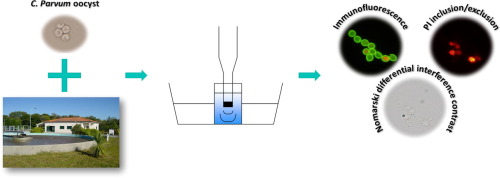Ultrasonics Sonochemistry ( IF 8.7 ) Pub Date : 2018-05-17 , DOI: 10.1016/j.ultsonch.2018.05.013 María Jesús Abeledo-Lameiro , Elvira Ares-Mazás , Hipólito Goméz-Couso

|
Water reuse is currently considered an innovative way to addressing water shortage that can provide significant economic, social and environmental benefits, particularly -but not exclusively- in water deficient areas. The potential transmission of infectious diseases is the most common concern in relation to water reclamation. Cryptosporidium is an important genus of protozoan enteropathogens that infect a wide range of vertebrate hosts, including humans. The infective form (oocyst) is highly resistant to the environmental conditions and disinfection treatments. Consequently, Cryptosporidium is the most common etiological agent identified in waterborne outbreaks attributed to parasitic protozoa worldwide. The present study evaluates the efficacy of ultrasound disinfection, at three power levels (60, 80 and
100 W), pulsed at 50% or in continuous mode, for inactivating the waterborne protozoan parasite Cryptosporidium parvum in simulated and real effluents from municipal wastewater treatment plants (MWTPs). Overall interpretation of the results shows that the application of ultrasound irradiation at
80 W power in continuous mode for an exposure time of 10 min drastically reduced the viability of
C. parvum. Thus, oocyst viabilities of 4.16±1.93%; 1.29±0.86%; 3.16±0.69%; and 3.15±0.87% were obtained in distilled water, simulated, real and filtered MWTP effluents, respectively (vs 98.57±0.01%, initial oocyst viability), as determined using inclusion/exclusion of the fluorogenic vital dye propidium iodide, an indicator of the integrity of the oocyst wall. Independently of the mode used (pulsed/continuous) and at 80 W power, higher level of oocyst inactivation was detected in MWTP effluents than in distilled water used as a control solution, may be due to the differences in the chemical composition of the samples. Comparison of the results obtained in both modes showed that use of the continuous mode yielded significantly lower oocyst viability. However, when the Dose parameter was considered (energy per volume unit), no statistically significant differences in oocyst viability were observed in relation to the type of mode used. The results demonstrate that ultrasound technology represent a promising alternative to the disinfection methods (ultraviolet irradiation and chlorine products) currently used in water reclamation as it drastically reduces the survival of Cryptosporidium oocysts, without changing the chemical composition of the water or producing toxic by-products.
中文翻译:

使用超声辐射灭活市政废水处理厂废水中的小隐孢子虫卵囊
当前,水的再利用被认为是解决水资源短缺的一种创新方式,可以提供重大的经济,社会和环境效益,特别是(但不仅限于)缺水地区。传染病的潜在传播是与水回收有关的最普遍关注的问题。隐孢子虫是原生动物肠病原的重要属,其感染包括人类在内的多种脊椎动物宿主。感染形式(卵囊)对环境条件和消毒处理具有高度抵抗力。因此,隐孢子虫是世界范围内因寄生虫原虫引起的水源性暴发中最常见的病原体。本研究评估了三种功率级别(60、80和80功率)下超声消毒的功效。
100 W),以50%或连续模式脉冲,用于灭活市政废水处理厂(MWTP)的模拟和实际废水中的水生原生动物寄生虫小隐孢子虫。结果的整体解释表明,超声波辐照的应用
连续模式下80 W功率的曝光时间为10分钟,大大降低了
C.小花。因此,卵囊生存力为4.16±1.93%。1.29±0.86%;3.16±0.69%; 分别在蒸馏水中,模拟的,实际的和过滤的MWTP废水中获得了3.15±0.87%的水(相对于98.57±0.01%的初始卵囊生存力),这是通过使用荧光活体染料碘化丙锭(包含碘的指示剂)确定的。卵囊壁的完整性。与所使用的模式(脉冲/连续)和80 W功率无关,在MWTP流出物中检测到的卵囊失活水平高于用作对照溶液的蒸馏水中的卵囊失活水平,这可能是由于样品化学成分的差异所致。比较在两种模式下获得的结果,表明使用连续模式可显着降低卵囊生存能力。但是,当剂量考虑参数(每体积单位的能量),相对于所用模式的类型,未观察到卵囊生存力的统计学显着差异。结果表明,超声波技术是目前水再生中使用的消毒方法(紫外线照射和氯产品)的有前途的替代方法,因为它大大降低了隐孢子虫卵囊的存活率,而不会改变水的化学成分或产生有毒的副产物。











































 京公网安备 11010802027423号
京公网安备 11010802027423号